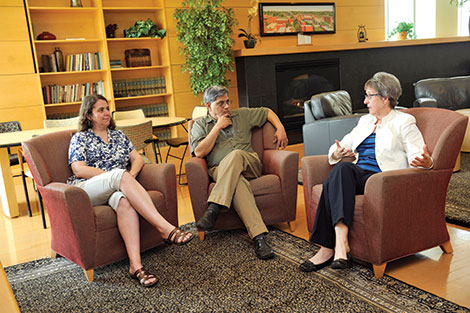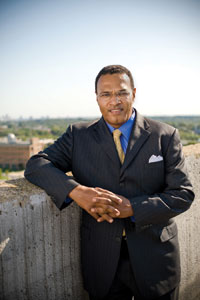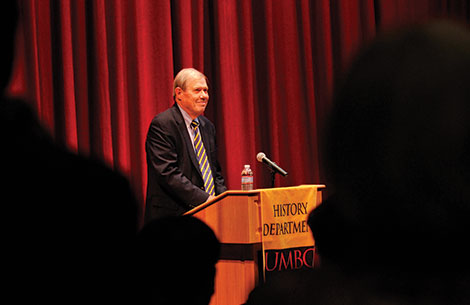The Hrabowski Fund for Innovation – established in honor of UMBC President Freeman A. Hrabowski, III, to help UMBC faculty pursue new approaches to teaching – made its inaugural awards in January. Among the recipients were Marie desJardins, a professor of computer science and electrical engineering, Nagaraj Neerchal, chair of the department of mathematics and statistics, and Leslie Morgan, a professor of sociology and anthropology.
Each project pushed UMBC’s already burgeoning culture of curricular innovation and pushed it into new directions and disciplines. DesJardins created the ACTIVE (Active Computing Teaching and InnoVation Environment) center to create a more collaborative environment for computer science students. Neerchal piloted a new “Math Gym” that allows students to exercise and improve specific mathematics skills. Morgan was the co-creator of a new “Wisdom Institute” that will harness the talents of UMBC’s emeritus professors.
As the deadline for the next round of the awards approaches on Friday, October 11, 2013, UMBC Magazine asked these awardees what inspires them to think creatively about teaching and the university – and how they took that extra step to make their vision happen.
* * * *
UMBC Magazine: How did you get the idea for ACTIVE?
DesJardins: In some ways, ACTIVE started with the CNMS Active Science Teaching and Learning Environment (CASTLE). I knew the CASTLE was a College of Natural and Mathematical Sciences thing, so I didn’t know anybody who was in there. But at some point someone mentioned that I might be able to use it for a class I was teaching.
And so I asked: “Would it be possible to use the center for some labs that I was doing for a class?” And it was available. So we did that for a few sessions. It was really nice to have this collaborative space where students can work online on something together. So I was wondering: Why don’t we have these kinds of labs in computer science? What we have now are the kind of sucky ones in the basement of the engineering building, with rows of big monitors that you can’t see past. So we started talking about: “Wow, wouldn’t it be cool if we had a resource like this.”
I started asking some of the people involved in CASTLE how they had put it together. And around that time our department got a corporate donation from BAE Systems. It wasn’t enough money to do something like the CASTLE, but it was a start. And then our department chair [Gary Carter, a professor of computer science and electrical engineering] said: “You know, I have a space you might be able to use.” So we started to believe that maybe we could do something like this.
When the Hrabowski Fund was announced, I was talking with Penny Rheingans [ a professor of computer science and electrical engineering] and I said: “We have to propose something.” I didn’t know what to propose but knew we had to propose something. And we settled on trying to do something like the CASTLE. But we knew that the Hrabowski Fund money wouldn’t be enough money to build the room. But we thought: “What if we assume that we have enough money from corporate donations to get the room. What would we do with it?”
And that was when inspiration struck. I knew we would never get enough money to build it if we had to buy 50 computers. And we’d never be able to maintain it if there are 50 computers in there. So we thought – what if we had a room like the CASTLE, but more configurable, and we call it a “laptop lab” and we make the students bring their own laptops? So we needed some resources to figure out just how to do that – and all those threads came together in our proposal.
What makes Math Gym innovative? The university already has programs for remediation for students who have trouble with mathematics.
Neerchal: You said the key word: “remediation.” When students don’t have the skills they are supposed to have we recommend that they take a remedial class. The word “remediation” has a negative tone to it, like “rehab.” In the Math Gym we substitute the negative terms with positive words such as “working out” and “building strength” instead of remediation, “coaches” instead of “helpers” or “assistants”. Students are not going there to work on a deficiency, but they are “working out” to build strength. It’s a paradigm change. If you want to be good at math, you have to work out.
There are a lot of parallels between sports and athletics. Like sports, Mathematics is also about skill. Just as you don’t build any muscles watching football, you don’t build any skills by just watching your teacher do mathematics.
So that’s why I called this project a “Math Gym.” Students will think of going there as a positive experience.
The “Wisdom Institute” seems to channel the power that emeritus faculty can provide to a campus in a new and attractive concept and name.
Morgan: I triggered the idea unintentionally. I had been doing a lot of work on aging. My research is on aging and the social dynamics of aging. And when I was named the Lipitz Professor of the Arts, Humanities and Social Sciences two years ago, I decided to focus on age and ageism as issues in society.
So I put together my talk, and Craig Saper [professor and chair of the Language, Literacy, and Culture program] came to my talk, and we then started an email exchange about the fact that as a maturing institution, UMBC is seeing a lot more retirements – and more retirements on the horizon – and that there is a lot of talent and experience and wisdom that those people have.
You can think of it as a brain drain or a talent drain or a wisdom drain, but there are a people who remain engaged with UMBC in a variety of ways. And the Provost’s Office had put together a list of ways that people can remain engaged. But there is no entity that brings that to people’s attention, or that actively moves forward to invite people who might be interested in staying engaged to do that.
So the idea of the Wisdom Institute is to both create a nexus where we can identify all of the opportunities, and collect all of these people and utilize their wisdom and experiences – including creating a course that would be more about life skills, and that would bring the experience and wisdom of emeritus faculty to bear on finding a path through life for graduate students, perhaps, or even for faculty and staff.
It has broadened a bit from the original proposal to approach this issue in a more holistic way. There are a lot of organizations in the country for retirees, but some of them are purely social. And knowing the faculty and staff at UMBC, people would like something with a little more engagement, where their wisdom and experience can be put to use at a level that they would like. It’s a way of keeping our heritage and tradition as part of the momentum moving forward.
UMBC has a tradition of curricular innovation. It also has a tradition of getting things done even when there is a scarcity of funding. How does the Hrabowski Award encourage both impulses at the university?
DesJardins: First of all, these innovations are risky. Sometimes they don’t go so well. And they also represent a lot of effort on the part of the people doing them. I also think that there is great variability across time and space and departments and economic cycles about how much support and recognition there is for that effort.
The reason I came to UMBC was to teach students. At the root, that’s what I care about. So if it has a benefit for students that is my primary motivator and my primary reward. But after a while of draining yourself to do that, if no one else around you is recognizing that value, it can get tiring/ so it makes such a huge difference when you feel like your efforts are valued.
The funding [provided by the Hrabowski award] is nice, but just the fact that there is a program, and a recognition and visibility is important. When there is an appreciation of the effort and the amount of energy that it takes to do those things, it creates a culture where it snowballs. People start thinking: “Oh, he did that and everybody really liked it.” There’s a glow around that activity that makes people feel like it would be worthwhile for them.
It also makes you feel like you’re not working in a vacuum. The award draws attention to the fact that people are doing these things and that you should do it too – and that we value that effort in our culture.
Neerchal: In our department, certain elements that make up the Math Gym were already being done.
A key piece of Math Gym is Quiz Zero. It started about five years ago. Students take a quiz on day zero – on the weekend before the class begins. Quiz Zero is diagnostics and placement all rolled into one. Some of our faculty members were doing it and we decided to scale it up for all our foundation courses.
We also have faculty who are giving extra help to students outside the classroom. Bonny Tighe [a senior lecturer in the department of mathematics and statistics], for instance, hosts a Friday afternoon extra office hour for her students in CASTLE. They’re basically doing problems. Math Gym combines these two ideas scaled up to all our foundations classes.
DesJardins: But it’s the commitment. We’re trying to get this space for ACTIVE renovated. We don’t have a huge amount of clout, but we can say that this is associated with the Hrabowski Fund and it helps get it done.
Morgan: You can say this is an entity. And we’ve gotten some funding. We are building.
So the awards provide a certain amount of momentum too?
Neerchal: Freeman mentions Math Gym almost every time I see him speak. The Hrabowski award enabled us to pilot the idea for two semesters. Hopefully we will get to continue to help the students beyond the pilot.
Morgan: That’s one of the hallmarks of the innovation culture at UMBC. People of good will can make it happen. And then it does happen.
DesJardins: Yes and when you get one of these awards you actually do have to make it happen!
Morgan: The award keeps a project on the agenda in a way that you feel responsible for. And we all set our goals and it gives us a reason to fit this in amongst all the different priorities.
Neerchal: We are already up and running. We are in the corridors of the math department. Based on the Quiz Zero scores, we targeted about 750 students with low QuizZero scores, and close to 600 showed up for a total of 1800 visits. One student came 34 times.
DesJardins: How did he do in his classes?
Neerchal: He did very well. In fact, he told me it was a life saver. And he is a non-traditional student.
A key aspect of Math Gym is what I call “closing the communication gap.” Students are sent to Math Gym by their instructors with the prescription: “You need to work out.” They come to Math Gym. We log them. We have an algorithm to determine a personalized workout plan. We keep track of their hours. When they are done, we provide the instructors feedback: “This student just finished the prescribed workout in the Math Gym.” We’re closing that communication loop.
DesJardins: We have three students who are going to be working for us to support ACTIVE. They are undergraduates who are interested in education and learning and teaching and pedagogy. It creates a lot of energy. We just went over to our space. It was a lab and it’s been disused for a few years. We’ve removed all the detritus. It’s a big open room. We’re going to have moveable furniture and moveable chairs and moveable white boards and projector screens. I was over there with one of these students and she was getting excited and that made me excited too.
Neerchal: Changing the language really helps to generate student interest. When we were recruiting student coaches for the Math Gym, we did not call them “tutors” or “helpers.” Words with negative connotation are out. Instead they are called “coaches.”
DesJardins: Language is important.
Neerchal: We made a call through the instructors for 8 positions, and we had 32 applications. So we decided do a group interview. Forty plus students showed up for the event.
Morgan: There is an Association for Retired Faculty and Staff that exists but the connotation of that is so different than a Wisdom Institute. A lot of these things are about the lens we use to frame the problem.
DesJardins: Our name is an acronym. Tim Finin [professor of computer science and electrical engineering] came up with that. He’s a genius with acronyms, with coming up with names for things that capture the feeling you want people to have. All three of these projects have names that crystallize their sense.
Neerchal: The name Math Gym is self explanatory. Recently I was introduced to an alumnus, who is a major donor to the university, as the creator of the Math Gym. Before I could begin my explanation, he said: “I wish it was there when I was a student here.”
It was inspiring to see Freeman donate his entire award check to start a foundation dedicated to promote innovation in the campus.
DesJardins: He’s taken this energy that was already there but a little dissipated and put a name and a program to it. It makes a big difference.
Morgan: I think it encourages people who have a great idea to not toss that idea away because they say I’m too busy.
– Richard Byrne ’86
Learn more about the Hrabowski Fund for Innovation here.
Tags: Summer 2013




